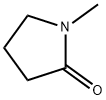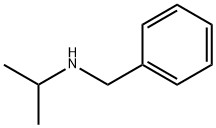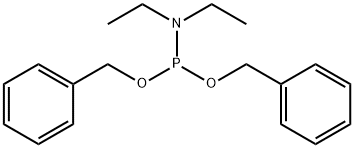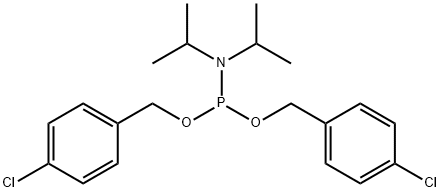DIBENZYL DIISOPROPYLPHOSPHORAMIDITE
- CAS NO.:108549-23-1
- Empirical Formula: C20H28NO2P
- Molecular Weight: 345.42
- MDL number: MFCD00191988
- EINECS: 629-628-9
- SAFETY DATA SHEET (SDS)
- Update Date: 2024-10-25 16:21:11

What is DIBENZYL DIISOPROPYLPHOSPHORAMIDITE?
Description
Dibenzyl diisopropylphosphoramidite is a versatile phosphitylating agent.
Chemical properties
Clear Colourless Liquid
The Uses of DIBENZYL DIISOPROPYLPHOSPHORAMIDITE
A versatile phosphitylating agent
The Uses of DIBENZYL DIISOPROPYLPHOSPHORAMIDITE
Dibenzyl N,N-diisopropylphosphoramidite may be used for the preparation of phosphopeptides. It is used for the synthesis of a GDP (guanosine diphosphate) analog, SML-8-73-1. It is useful for nucleotide coupling.
What are the applications of Application
Dibenzyl N,N-Diisopropylphosphoramidite is A compound useful for nucleotide coupling
Properties of DIBENZYL DIISOPROPYLPHOSPHORAMIDITE
| Boiling point: | 130 °C0.55 mm Hg(lit.) |
| Density | 1.028 g/mL at 25 °C(lit.) |
| refractive index | n |
| Flash point: | 158 °F |
| storage temp. | 2-8°C |
| solubility | Soluble in chloroform. |
| form | Oil |
| pka | 4.50±0.70(Predicted) |
| color | Clear Colourless |
| Sensitive | Moisture Sensitive |
| BRN | 3616864 |
| CAS DataBase Reference | 108549-23-1(CAS DataBase Reference) |
Safety information for DIBENZYL DIISOPROPYLPHOSPHORAMIDITE
| Signal word | Warning |
| Pictogram(s) |
 Exclamation Mark Irritant GHS07 |
| GHS Hazard Statements |
H227:Flammable liquids H315:Skin corrosion/irritation H319:Serious eye damage/eye irritation H335:Specific target organ toxicity, single exposure;Respiratory tract irritation |
| Precautionary Statement Codes |
P210:Keep away from heat/sparks/open flames/hot surfaces. — No smoking. P261:Avoid breathing dust/fume/gas/mist/vapours/spray. P264:Wash hands thoroughly after handling. P264:Wash skin thouroughly after handling. P280:Wear protective gloves/protective clothing/eye protection/face protection. P305+P351+P338:IF IN EYES: Rinse cautiously with water for several minutes. Remove contact lenses, if present and easy to do. Continuerinsing. P370+P378:In case of fire: Use … for extinction. P405:Store locked up. P403+P235:Store in a well-ventilated place. Keep cool. P501:Dispose of contents/container to..… |
Computed Descriptors for DIBENZYL DIISOPROPYLPHOSPHORAMIDITE
New Products
4-Fluorophenylacetic acid 4-Methylphenylacetic acid N-Boc-D-alaninol N-BOC-D/L-ALANINOL Tert-butyl bis(2-chloroethyl)carbamate 3-Morpholino-1-(4-nitrophenyl)-5,6-dihydropyridin- 2(1H)-one Furan-2,5-Dicarboxylic Acid Tropic acid S-2-CHLORO PROPIONIC ACID ETHYL ISOCYANOACETATE 2-Bromo-1,3-Bis(Dimethylamino)Trimethinium Hexafluorophosphate (6-METHYL-[1,3]DITHIOLO[4,5-b]QUINOXALIN-2-ONE INDAZOLE-3-CARBOXYLIC ACID 4-IODO BENZOIC ACID (2-Hydroxyphenyl)acetonitrile 4-Bromopyrazole 5,6-Dimethoxyindanone 2-(Cyanocyclohexyl)acetic acid 4-methoxy-3,5-dinitropyridine 2-aminopropyl benzoate hydrochloride 1-(4-(aminomethyl)benzyl)urea hydrochloride diethyl 2-(2-((tertbutoxycarbonyl)amino) ethyl)malonate tert-butyl 4- (ureidomethyl)benzylcarbamate Ethyl-2-chloro((4-methoxyphenyl)hydrazono)acetateRelated products of tetrahydrofuran







![BIS[1-(2-NITROPHENYL)ETHYL] N,N-DIISOPROPYLPHOSPHORAMIDITE](https://img.chemicalbook.in/StructureFile/ChemBookStructure22/GIF/CB2648389.gif)
You may like
-
 Dibenzyl N,N-Diisopropylphosphoramidite CAS 108549-23-1View Details
Dibenzyl N,N-Diisopropylphosphoramidite CAS 108549-23-1View Details
108549-23-1 -
 Dibenzyl diisopropylphosphoramidite, 95% CAS 108549-23-1View Details
Dibenzyl diisopropylphosphoramidite, 95% CAS 108549-23-1View Details
108549-23-1 -
 Dibenzyl diisopropylphosphoramidite 98% (GC) CAS 108549-23-1View Details
Dibenzyl diisopropylphosphoramidite 98% (GC) CAS 108549-23-1View Details
108549-23-1 -
 Dibenzyl N,N-diisopropylphosphoramidite CAS 108549-23-1View Details
Dibenzyl N,N-diisopropylphosphoramidite CAS 108549-23-1View Details
108549-23-1 -
 1975-50-4 98%View Details
1975-50-4 98%View Details
1975-50-4 -
 2-HYDROXY BENZYL ALCOHOL 98%View Details
2-HYDROXY BENZYL ALCOHOL 98%View Details
90-01-7 -
 14714-50-2 (2-Hydroxyphenyl)acetonitrile 98+View Details
14714-50-2 (2-Hydroxyphenyl)acetonitrile 98+View Details
14714-50-2 -
 118753-70-1 98+View Details
118753-70-1 98+View Details
118753-70-1
Statement: All products displayed on this website are only used for non medical purposes such as industrial applications or scientific research, and cannot be used for clinical diagnosis or treatment of humans or animals. They are not medicinal or edible.